
We’d love to keep up with the pictures and videos from your fabulous bike tour!
Give us a follow on Instagram at @bikespaintours and tag us in the posts from your trip.
Please leave your luggage in the hotel reception each morning (by 8am at the latest) so that it can be transferred to your next hotel. Make sure that your luggage is clearly labelled with the nametag provided. In case of any issues with the luggage transfer, please contact Tuitrans on (+34) 638 55 52 53.
Call the Bike Spain Tours office on +34 915 590 653, or out of office hours call +34 677 356 586. We will get you where you need to be and get you the help you need.
In order to prove your status as a pilgrim (and be awarded your Compostela pilgrim certificate once you arrive in Santiago), you will need to obtain a credencial (pilgrim passport) at the start of your journey. In Porto, you can get your credencial from the Albergue de Peregrinos Porto (open daily 2:30pm – 8pm) or from Porto Cathedral (open daily 9am – 6:30pm). The credencial costs 2€, payable in cash.
Once you have your credencial, make sure that you get it stamped at least twice per day as you travel to Santiago. You can receive stamps in hotels, restaurants, churches, bars, cafés and many other places that you might visit along the way; we recommend that you try to get as many stamps as possible to turn your credencial into a unique souvenir of your trip!
Wednesday, 22nd May: Porto
Accommodation: Hotel Eurostars das Artes
Welcome to the Camino, and the start of an amazing tour!
Once you’ve checked into your accommodation, you will need to obtain your credencial (pilgrim passport) from the Albergue de Peregrinos Porto (open daily 2:30pm – 8pm) or from Porto Cathedral (open daily 9am – 6:30pm). The credencial costs 2€, payable in cash. You will need to get this stamped twice a day at hotels, restaurants and anywhere else you might visit in order to be awarded your certificate of pilgrimage once you arrive in Santiago!
In case you need assistance with your bikes, please contact our local partners, Biclas & Triclas (open daily 10am – 8pm) on (+351) 933658008, or visit their shop at Rua Nova da Alfândega, 108, R/C, Miragaia.
At leisure in Porto
The city of Porto, built along the hillsides overlooking the mouth of the Douro river, is an outstanding urban landscape with a 2,000-year history. The historic centre, Luiz I Bridge and Monastery of Serra do Pilar, are recognised as a UNESCO World Heritage Site.
Eating and drinking in Porto
Friday, 24th May: Porto – Vila do Conde
Route: 40.6 km/25.2 miles
Elevation: +267m/+875 ft
Accommodation: Villa C Boutique Hotel
The Camino begins!
Please leave your luggage in the hotel reception each morning (by 8am at the latest) so that it can be transferred to your next hotel. Make sure that your luggage is clearly labelled with the nametag provided. In case of any issues with the luggage transfer, please contact Tuitrans on (+34) 638 55 52 53.
Your first cycle route takes you along the banks of the Douro River all the way to the Atlantic Ocean, to follow the coast northwards past long, sandy beaches. If all that cycling makes you peckish, you’ll find plenty of beachfront grills that will barbecue freshly-caught fish for you to give you energy for the next part of your ride!
You’ll find plenty of opportunities for a swim among the way, at the many beaches or at Piscina das Marés (open daily in summer 9am – 7pm: the seawater swimming pool designed by famous Portuguese architect Álvaro Siza Vieira.
You’ll spend the night in Vila do Conde, a pretty town built during the Portuguese Golden Age, or the ‘age of discovery’, when mariners set sail for sub-Saharan Africa and India for the first time.
The town’s skyline is dominated by the imposing Monastery of Santa Clara, as well as the aqueduct that was built in the 18th century to bring water to the monastery and of which nearly 1000 arches still remain.
At leisure in Vila do Conde
Vila do Conde is a favourite with daytripping locals, who are attracted to its beautiful beaches, excellent food and relaxed ambience.
Eating and drinking in Vila do Conde
For dinner, we recommend Restaurante o Cangalho (open Tue – Sat 8pm – 11pm) or Os Eusébios to replace some of those calories with a traditional francesinha (open Tue – Sun 7pm – 11pm).
Saturday, 25th May: Vila do Conde – Viana do Castelo
Route: 52.1 km/32.4 miles
Elevation: +330m/+1083 ft
Accommodation: Hotel Melo Alvim
Today’s route continues northwards along the coastline, passing by sand dunes and traditional windmills. At Fao, you’ll cross the bridge over the river Cádavo and into Esposende, where you’ll follow the estuary before turning slightly inland to explore ancient medieval town such as Castelo do Neiva, whose Benedictine monastery dates back to the 11th century, before crossing the 19th century bridge, designed by famous French architect Gustav Eiffel, over the River Lima into Viana do Castelo.
You’ll spend tonight in the picturesque town of Viana do Castelo, overlooked by the hilltop Basilica del Sagrado Corazón, which was inspired by the Sacre Coeur in Paris.
At leisure in Viana do Castelo
Eating and drinking in Viana do Castelo
Your hotel has its own excellent craft beer bar and restaurant; however, if you would like to explore the town further, we recommend popular local option Casa Primavera-Taberna Soares (open Wed – Sat and Mon 5pm – 10pm)
Sunday, 26th May: Viana do Castelo – Baiona
Route: 60.4 km/37.5 miles
Elevation: +526m/1727 ft
Accommodation: Parador de Baiona
Today you’ll enjoy fabulous views as you continue to follow the coastline north, passing by ancient monasteries and small popular shrines, to the pretty fishing village of Vila Praia de Âncora, where we’ll enjoy a ride along the seafront boulevard, which borders the town’s beach, fininishing at the star-shaped Lagarteira fort, which has protected the town from sea attacks since the mid 17th century. If you fancy a bite to eat, we recommend Casa dos Caracois (open Thu – Tue 11am – 3pm), which specialises in snails!
Heading out of Vila Praia de Âncora, we’ll pass by the clifftop chapel and cross of San Isidrio until we reach the medieval border town of Caminha. Don’t miss the rude gargoyle at the church of Nossa Senhora da Assunção, a symbol of the historic enmity between Portugal and Spain!
In Caminha, you’ll take a boat across the River Miño to begin the Spanish portion of your journey! The boat service is run by Xacobeo Transfer, with hourly departures between 7:30am and 5:30pm from Puerto Sporting Club Caminhense. Tickets cost 8€, payable locally in cash or online. If purchasing online, make sure to select the bike rate, and the correct journey option: Caminha (Portugal) to A Pasaxe – Camposancos (A Guarda – España).
Your camino continues in the charming fishing village of A Guarda, where we recommend a brief stop to admire the colourful fishermen’s houses and the Plaza do Reló, the heart of the medieval old town. Those interested in history might consider cycling up Monte de Santa Tegra to visit the fortified celtic town at the top of the hill, which dates back to the 4th century BC (this diversion entails an additional: 7km/+350m).
From A Guarda, you’ll follow a coastal cycle path along one of the wilder portions of Spain’s Atlantic coast. Shortly after leaving the town, you’ll spot some traditional cetáreas: rockpools once used to store captured crustaceans before transporting them to be sold.
Along the way, you’ll pass by the beautiful beachfront Monastery de Santa María de Oia, which dates back to the 12th century, and the Bronze Age Castro de A Cabeciña. We also recommend a photo stop at the beautiful Vello de Silleiro lighthouse.
Once in Baiona, you can spend some time exploring the city’s atmospheric historic centre and quaint fishing port. The town’s most important historic building is the Castelo de Monterreal, a medieval fortress that still retains the cannons once used to defend the town from pirates, and which offers fabulous views over the bay from the parapet. Nowadays, it is a luxury hotel; your hotel for the night, in fact!
At leisure in Baiona
Eating and drinking in Baiona
Your hotel has its own excellent in-house restaurant with spectacular views over the bay and the Cíes Islands. Don’t miss the sight of the sun setting into the Atlantic Ocean!
If you would like to explore the town further, we recommend the seafront Taberna Mendoza (open for dinner Mon – Sat).
Tuesday, 28th May: Baiona – Pontevedra
Route: 66.8 km/41.5 miles
Elevation: +905m/2968 ft
Accommodation: Parador de Pontevedra
Today, the Camino takes you around the bay of Baiona and over the Romanesque bridge into A Ramallosa and continues inland towards Vigo, Galicia’s largest city. It’s well worth stopping here to admire the many sculptures that decorate the city, including one dedicated to Jules Verne’s 20,000 Leagues Under the Sea, and to enjoy the city’s fantastic tapas culture. Some of our favourites are Taberna A Pedra (open 12pm – 4pm Wed – Sun), O Portón, situated on the famous fishermen’s street (open 12pm – 4pm Wed – Sun), Detapaencepa (open daily 12:30 – 4pm) and Tapas Areal (open daily 1:30pm – 4:30pm).
Leaving Vigo behind, we’ll follow a vía verde (disused railway line converted into a traffic-free cycle path) towards Redondela, passing by the Rande Bridge. Here in 1702, a fleet of Spanish galleons were sunk, along with their treasure of New World gold, by a British-Dutch fleet. The gold was never found, so keep an eye out for it as you pass by! In Rande, you can also take a brief detour (4km/+175m) up to the Miradoiro do Campo de Rata, where you can sit on “the best bench in the world” and enjoy fabulous views over the bay!
You’ll continue on to the pretty town of Redondela, known locally as the villa de los viaductos due to the two imposing railway bridges constructed towards the end of the 19th century. Your next stop is Arcade, famous for the oysters that are cultivated in the Vigo esturary, which you can try at one of the town’s many marisquerías. Leaving Arcade, you’ll cross the medieval bridge into Pontesampio, and from here follow the course of the River Tomenza into Pontevedra.
You’ll spend the night in the interesting Camino city of Pontevedra. Pontevedra is the capital of the Rías Baixas albariño wine region, so we highly recommend trying some of this light Galician white wine.
At leisure in Pontevedra
Eating and drinking in Pontevedra
Your hotel has its own excellent restaurant, specialising in fresh seafood from the Rías Baixas. If you would like to explore the city a little more, we recommend a tapas crawl around the old quarter to try the local seafood.
Wednesday, 29th May: Pontevedra – Santiago de Compostela
Route: 65.3 km/40.6 miles
Elecation: +986m/+3234 ft
Accommodation: Hostal Reyes Católicos
The Camino today takes you out of Pontevedra and towards the spa town of Caldas de Reis, situated at the confluence of the rivers Bermaña and Umia, and well-known for its geothermal hot springs. At Aldeíña and Caldas, you have the oppotrunity of taking a short detour to visit beautiful waterfalls, where you can still see some traditional Galician muiños (windmills).
Once in Caldas de Reis, we recommend a snack stop at taberna O Muiño (open Tue – Sun, 1pm – 3:30pm) , which has been serving up fish from the nearby river Umia since 1947. Trout and lamprey, often served in empanadas (pies) are among the traditional local specialties.
From here, you’ll continue north along quiet forest paths towards the town of Padrón, famous for the small green peppers of the same name. We highly recommend that you make a quick stop in the two main squares – Praza das Traviesas and Praza de Macías – to try a tapa of freshly fried and salted peppers, but remember the saying: “Padrón peppers, some are hot, and others are not!” If you’re still hungry, add a tapa of pulpo: the famous Galician octopus.
In Padrón, you can also visit the church of Santiago (open Wed – Mon 10am – 9pm), which houses the pedrón: a block of granite that was once part of a Roman temple to Neptune and which is said to have served as mooring for the boat that carried the remains of Saint James from the Holy Land to Galicia.
Leaving Padrón behind, you’ll face one last climb up to Santiago de Compostela and the end of your journey!
The official end-point of the Camino in Santiago de Compostela is the Cathedral, located in Plaza del Obradoiro. We recommend taking a break in the plaza to celebrate your achievement and soak up the amazing atmosphere. There is something indescribably human about the sight of hundreds of daily pilgrims arriving into the plaza, just as countless others have done over the centuries.
Inside the Cathedral, pilgrims traditionally embrace the statue of St James and visit his tomb. If you’d like to carry out this ritual, you can enter the Cathedral via Porta de Acibechería in Plaza da Inmaculada (daily from 8:30am – 9pm).
When you’re ready, you can visit the Pilgrim’s Office at Rúa das Carretas, 33 (open daily 10am – 6pm), where you can obtain the Compostela: the document certifying you as an official pilgrim! You can also request the Certificate of Distance, which reflects the start point of your pilgrimage, the number of kilometres travelled and the start and finish dates. This Certificate costs 3€, payable in cash at the Pilgrim Office.
Pilgrim’s Mass takes place in the Cathedral daily at 7:30am, 9:30am, 12:00pm and 7:30pm. At the beginning of the Pilgrim’s Mass, a list of the number of pilgrims who have been received in the Pilgrims’ Office in the last 24 hours is read out. Where they have travelled from and where they began their pilgrimage is also read out at the beginning of the service. If you’re lucky, you might even see the Botafumeiro, the enormous censer filled with incense and swung over the heads of mass attendees to counteract the smell of recently-arrived pilgrims!
At leisure in Santiago de Compostela
Santiago de Compostela was, without a doubt, the most important city in Christian medieval Spain. It’s world-renowned for its cultural and religious significance, and each year thousands of travellers come to visit.
Eating and drinking in Santiago de Compostela
Santiago de Compostela also has a fantastic tapas culture. You will receive one free tapa per drink purchased, so we recommend that you stick with small glasses of albariño wine! Some of our favourites are Bar La Tita (enormous portions of tortilla) Petiscos do Cordeal (seafood), Benboa (seafood), Viñoteca Ventosela (cheese and charcuterie), Raices Gallegas (traditional Galician dishes including zorza and raxo) and Orella (pig’s ear). We also recommend a visit to Casa Antonio, which serves wine in a traditional Galician cunca (bowl)!
Thursday, 30th May: Santiago de Compostela
Accommodation: Hostal Reyes Católicos
At leisure in Santiago de Compostela.
Friday, 31st May: Porto
Accommodation: Hotel Eurostars das Artes
12pm: Private transfer from Parador de Santiago (Santiago de Compostela) to Hotel Eurostars das Artes (Porto). The taxi company is Traslados Compostela. In case of any issues, call (+34) 680 24 38 48.
At leisure in Porto.
Tuesday, 4th June: Departure day
After breakfast, our services come to an end.
We hope you had a wonderful Camino with us!
Eurostars das Artes
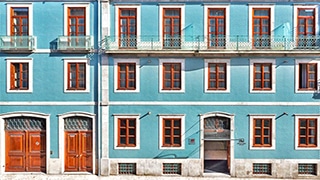
The Eurostars Das Artes Hotel comprises two buildings, one historical and the other modern, and has a sky-blue tiled facade to welcome guests.
This hotel is located in the center of Porto. It is surrounded by art and culture and it’s the perfect place for someone looking to enjoy a good port wine. Elegance and good taste invade all corners of the hotel.
Villa C Boutique Hotel
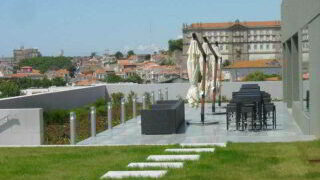
Villa C Boutique Hotel is located on the south bank of the River Ave, in Azurara. This 4-star property features a luxury spa and rooms with a balcony.
This boutique hotel features a restaurant, a bar, a spa, a gym and conference rooms making it the perfect spot for business and leisure. In addition, the hotel features a lobby market, a grocery store and an outdoor lounge.
Hotel Casa Melo Alvim
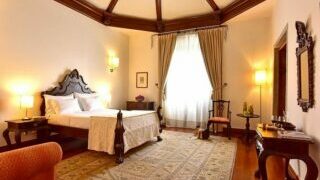
Casa Melo Alvim hotel is located in the historic centre of Viana do Castelo.
It is the oldest urban manor house in the town, having been built in 1509 in the Manueline style. This manor house has been carefully restored, and transformed into a comfortable and welcoming 4 star hotel.
Guests can enjoy a luxury breakfast in the cozy bar with live piano music. A Baroque-style staircase leads to the upper floors and the library.
Parador de Baiona
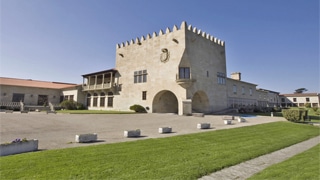
To the south of the Rías Baixas, protected by the sea and with views over the beautiful Bay of Baiona, is the peninsula of Monterreal. There, we find the Parador de Baiona: a historical castle with spectacular views of the ocean.
A mix between a medieval castle and a Galician stately home, the Parador offers regal and elegant rooms, carefully decorated to will take you back in time to another age. Outstanding features include the majestic stone stairway in the reception area and a huge garden, equipped with a large swimming pool, from where you can view the entire bay.
Parador de Pontevedra
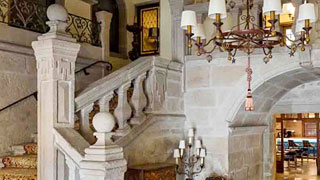
You will be welcomed by a stately carved stone staircase.The building is decorated with beautiful antiques and classic furniture.
The Parador, once the residence of the counts of Maceda, is located in the old quarter of the magnificent city of Pontevedra. It combines regal, noble and stately styles with charming rural elements. The surrounding area invites you to visit coves and beaches, and to enjoy fine seafood and excellent wine.
Parador de Santiago – Hostal Reis Catolicos
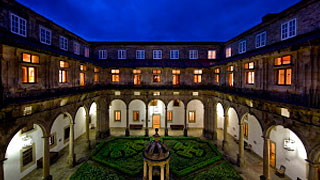
The Parador de Santiago is a blend of history, art and tradition. It is the dream stay for pilgrims and the emblem of Santiago.
The hotel is located in Obradoiro Square near the cathedral, creating an area of spectacular beauty in one of the most visited provincial capitals in the world. A stay at this Parador means a visit to a truly unique and exclusive location.
Being on a bike tour shouldn’t mean constantly worrying about your bike breaking down. Nevertheless, bikes are machines, and issues can occur. Here’s what to look for if something doesn’t sound, feel, or work right.
ACCIDENTS: In case of an accident, keep calm, get off the road and go to a safe place (such as the hard shoulder) where you can evaluate the problem. If you suspect that you need medical care, call the Spanish emergency services on 112, explaining clearly where you are and what the problem is. Have your passport and your insurance documentation handy before calling. Please contact our office immediately after speaking with emergency services.
Remember that personal insurance it is not included on our self-guided tours. We offer an optional insurance policy. If you choose not to purchase this, please make sure that you keep own insurance documentation with you (including your passport).
The tour price does not include any roadside assistance with bicycle maintenance (e.g. flat tires) or any other taxi transfers during the tour. Any repairs that need to be caarried out on the bicycles that are not a result of negligence on Bike Spain Tours’ part will be paid for by the client.
HELMET: Cycling on the road in Spain without a helmet is illegal and unsafe; remember to wear your helmet at all times.
To check the weather before you leave on your trip, please take a look at current weather conditions at www.weatheronline.co.uk. For historical temperature and precipitation statistics visit www.weatherbase.com or take a look at the Spanish Meteorological website with detailed information per region (http://www.aemet.es/en/elclima/datosclimatologicos/valoresclimatologicos)
The history of Spain is a compendium of influences from the different cultures that have lived in the country. The first settlers on the Peninsula were the Celts and the Iberians. The Roman presence in Hispania lasted for seven centuries, during which time the basic borders of the Peninsula in relation to other European towns were set up. Many institutions were inherited from Rome such as the concept of family, Latin as a language, religion and law. At the start of the 5th century new settlers from the North arrived and settled on the Peninsula: the Visigoths in the interior and the Swabians on the West. The decomposition of the Visigoth state apparatus would lead to the successive infiltration of Arab and Berber troops from the other side of the Straits of Gibraltar at the beginning of the 8th century. In the middle of the 8th century the Muslims had completed occupation and Cordoba became the center of the flourishing Andalusian state. The Arab presence in Spain would last for almost seven centuries and leave an indelible mark on the Spanish cultural heritage.
Following a long period of peaceful coexistence, the small Christian strongholds in the North of the Peninsula took on a leading role in the Reconquest, which ended with the capture of Granada in 1492 under the reign of the Catholic King and Queen, traditionally considered the founders of peninsular unity and the imperial management of the Spanish revival. The 16th century represents the zenith of Spanish hegemony in the world, a process that would last until the middle of the 17th century. Following the death of Charles II, the last of the Austrians, who died without having had children, Phillip V inaugurated the dynasty of the Bourbons of Spain.
The crisis of the Old Order opened the doorway to the Napoleonic invasion. The War of Independence was a war against the French invasion, but also a revolutionary war due to the decisive involvement of the people and the clear formation of a national consciousness that would later shape the 1812 Constitution. The Courts of Cadiz thereby enacted one of the first Constitutions of the world which ratified that sovereignty would reside in the nation. The conflict between liberalists and absolutists, or in other words, between two different ways of perceiving the establishment of the state, would be one of the longest Spanish conflicts throughout the 19th century.
The ballot box is introduced into Spain and with it the first democratic experience of the 20th century: the second Republic, a brief attempt to introduce the reformations the country needed, frustrated by General Franco’s military rising and the outbreak of the Civil War in 1936. The military victory of General Franco gave way to a long dictatorial period that would last until 1975. Following his death, the Spanish peacefully made the transition from dictatorship to democracy in a process known as ‘the Spanish model’. Don Juan Carlos I, as King of the Spanish people, became the chief of a social and democratic state of law, which molded the Constitution of 1978.
More information…? Should you be interested in a specific theme, please check here, you will find many info about culture, environmental issues, nature, society, geography and politics.
In Spain you have exquisite and innovative dishes with the guarantee of internationally prestigious chefs. The highest quality products from the best producers, recipes combining popular tradition with artistic creation and offer you exciting, new flavors. Spain’s culinary revolution, headed by master chefs like Ferrán Adriá, Arzak and Berasategui turns the pleasure of good food into a luxury for the senses that is at its finest when savored in Spain.
Spanish cuisine is nowadays recommended in the finest restaurants, heralded by the most prestigious critics and demanded by millions of consumers over the world. It has gone through a real revolution, which, in the time of a few short years, has put Spain at the top of international cuisine. With traditional styles as the basis, a modern, innovative cuisine has developed, identified by the use of quality products and by the creativity of its chefs.
To read more about Spain’s cuisine
The Way of St. James or St. James’ Way (Spanish: El Camino de Santiago) is the pilgrimage route to the Cathedral of Santiago de Compostela in Galicia in north-western Spain, where tradition has it that the remains of the apostle Saint James are buried. The Camino has existed as a Christian pilgrimage for well over 1,000 years, and there is evidence of a pre-Christian route as well. Throughout the medieval period it was one of the three most important Christian pilgrimages undertaken. Indeed, it was only these pilgrimages—to Jerusalem, to Rome, and to Santiago de Compostela—which could result in a plenary indulgence, which frees a person from the penance due for sins.
The route was declared the first European Cultural Route by the Council of Europe in October 1987 and inscribed as one of UNESCO’s World Heritage Sites in 1993. Legend has it that the remains of the apostle James were brought to Galicia for burial. In 813, according to medieval legend, the light of a bright star guided a shepherd who was watching his flock at night to the burial site in Santiago de Compostela. The shepherd quickly reported his discovery to the bishop of Iria, Bishop Teodomiro. The bishop declared that the remains were those of the apostle James and immediately notified King Alfonso II in Oviedo. To honor St. James, the cathedral was built on the spot where his remains were said to have been found.
In the early 1980s only a few pilgrims a year arrived in Santiago. However, since the late 1980s the Way has attracted a growing number of modern-day pilgrims from all around the globe.
Most pilgrims carry a document called the credencial. The credencial is a pass which gives access to inexpensive, sometimes free, overnight accommodation in refugios along the trail. Also known as the “pilgrim’s passport”, the credencial is stamped with the official St. James stamp of each town or refugio at which the pilgrim has stayed. It provides walking pilgrims with a record of where they ate or slept, but also serves as proof to the Pilgrim’s Office in Santiago that the journey has been accomplished according to an official route. The credencial is available at pilgrim hostels, tourist offices, some local parish houses, and outside Spain, through the national St. James organisation of that country. The stamped credencial is also necessary if the pilgrim wants to obtain a Compostela, a certificate of completion of the pilgrimage.
The Compostela is a certificate of accomplishment given to pilgrims on completing the Way. To earn the Compostela, pilgrims need to walk a minimum of 100 km or cycle at least 200 km. The pilgrim passport is examined carefully for stamps and dates. If a key stamp is missing, or if the pilgrim does not claim a religious purpose for their pilgrimage, the Compostela may be refused.
The scallop shell, often found on the shores in Galicia, has long been the symbol of the Camino de Santiago. Over the centuries the scallop shell has taken on mythical, metaphorical and practical meanings. Two versions of the most common myth about the origin of the symbol concern the death of Saint James, who was killed in Jerusalem for his convictions.
–Version 1: After James’ death, his disciples shipped his body to the Iberian Peninsula to be buried in what is now Santiago. Off the coast of Spain a heavy storm hit the ship, and the body was lost to the ocean. After some time, however, the body washed ashore undamaged, covered in scallops.
-Version 2: After James’ death his body was mysteriously transported by a ship with no crew back to the Iberian Peninsula to be buried in what is now Santiago. As James’ ship approached land, a wedding was taking place on the shore. The young bridegroom was on horseback, and on seeing the ship approaching, his horse got spooked, and the horse and rider plunged into the sea. Through miraculous intervention, the horse and rider emerged from the water alive, covered in seashells.
The scallop shell also acts as a metaphor. The grooves in the shell, which come together at a single point, represent the various routes pilgrims travelled, eventually arriving at a single destination: the tomb of James in Santiago de Compostela. The scallop shell also served practical purposes for pilgrims on the Camino de Santiago. The shell was the right size for gathering water to drink or for eating out of as a makeshift bowl.
Today thousands of Christian pilgrims and non-Christian pilgrims each year set out from their homes or popular starting points across Europe, to make their way to Santiago de Compostela. Most travel by foot, some by bicycle, and a few travel as some of their medieval counterparts did, on horseback or by donkey. In addition to people undertaking a religious pilgrimage, the majority are travellers and hikers who walk the route for non-religious reasons: travel, sport, or simply the challenge of weeks of walking in a foreign land. Also, many consider the experience a spiritual adventure to get away from the bustle of modern life.
Info
About UsContact Info
Plaza de la Villa 1,
28005 Madrid
+34 915 590 653
info@bikespain.com
